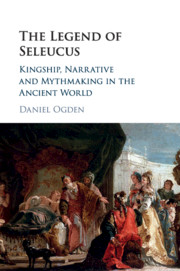Book contents
- The Legend of Seleucus
- The Legend of Seleucus
- Copyright page
- Epigraph
- Additional material
- Contents
- Figures
- Maps
- Tables
- Acknowledgements
- A Note on Conventions in Relation to the Alexander Romance
- Abbreviations
- Introduction
- 1 Birth Myths and Omens of Greatness
- 2 Seleucus’ Horseback Flight from Babylon
- 3 Omens and Myths of City and Cult Foundation
- 4 Combabus and Stratonice
- 5 Antiochus and Stratonice
- 6 Omens of Death, Death and Revenge
- 7 Coins, Texts and Traditions
- Book part
- References
- Index
- References
References
Published online by Cambridge University Press: 19 May 2017
- The Legend of Seleucus
- The Legend of Seleucus
- Copyright page
- Epigraph
- Additional material
- Contents
- Figures
- Maps
- Tables
- Acknowledgements
- A Note on Conventions in Relation to the Alexander Romance
- Abbreviations
- Introduction
- 1 Birth Myths and Omens of Greatness
- 2 Seleucus’ Horseback Flight from Babylon
- 3 Omens and Myths of City and Cult Foundation
- 4 Combabus and Stratonice
- 5 Antiochus and Stratonice
- 6 Omens of Death, Death and Revenge
- 7 Coins, Texts and Traditions
- Book part
- References
- Index
- References
- Type
- Chapter
- Information
- The Legend of SeleucusKingship, Narrative and Mythmaking in the Ancient World, pp. 351 - 378Publisher: Cambridge University PressPrint publication year: 2017



